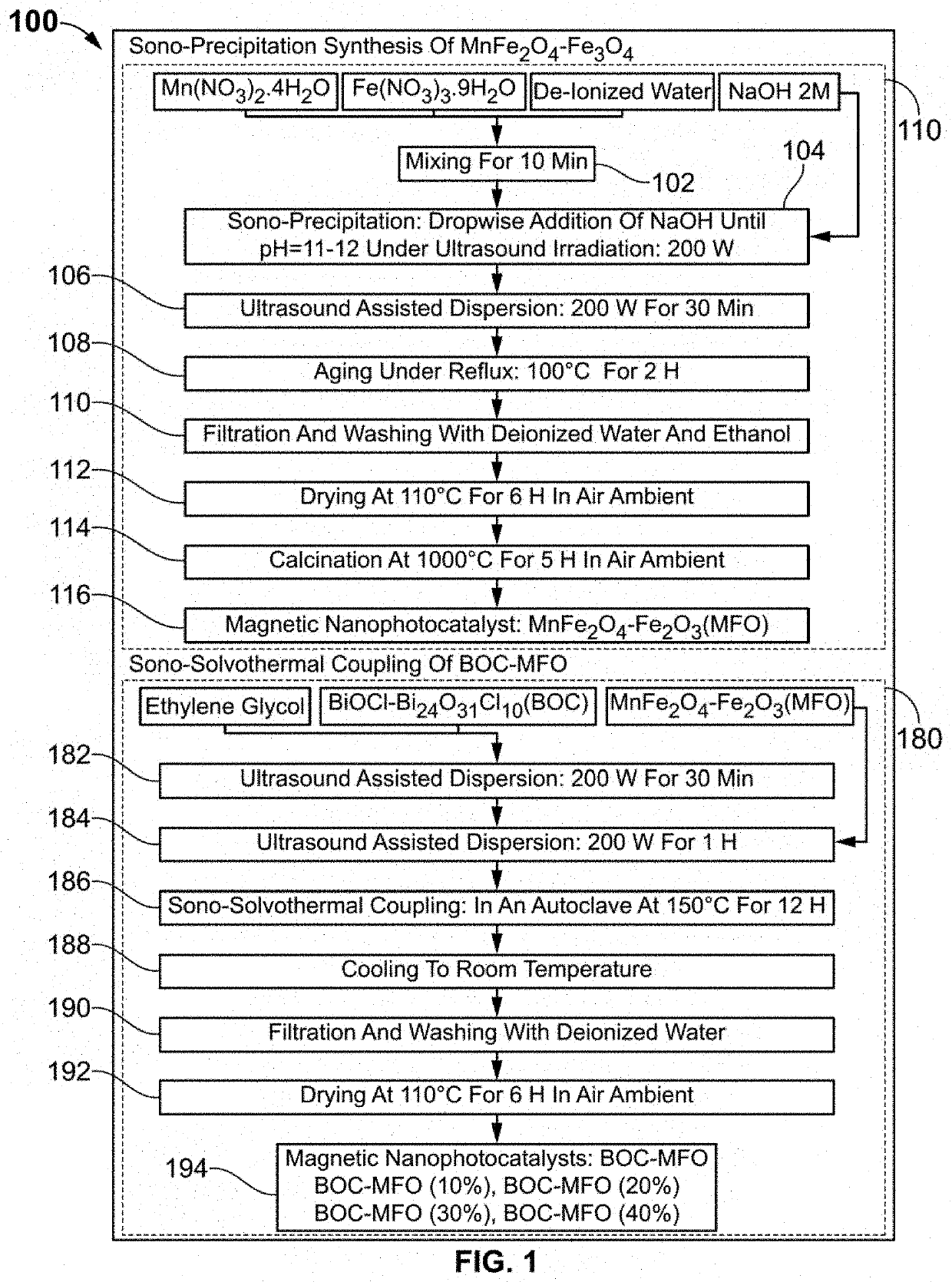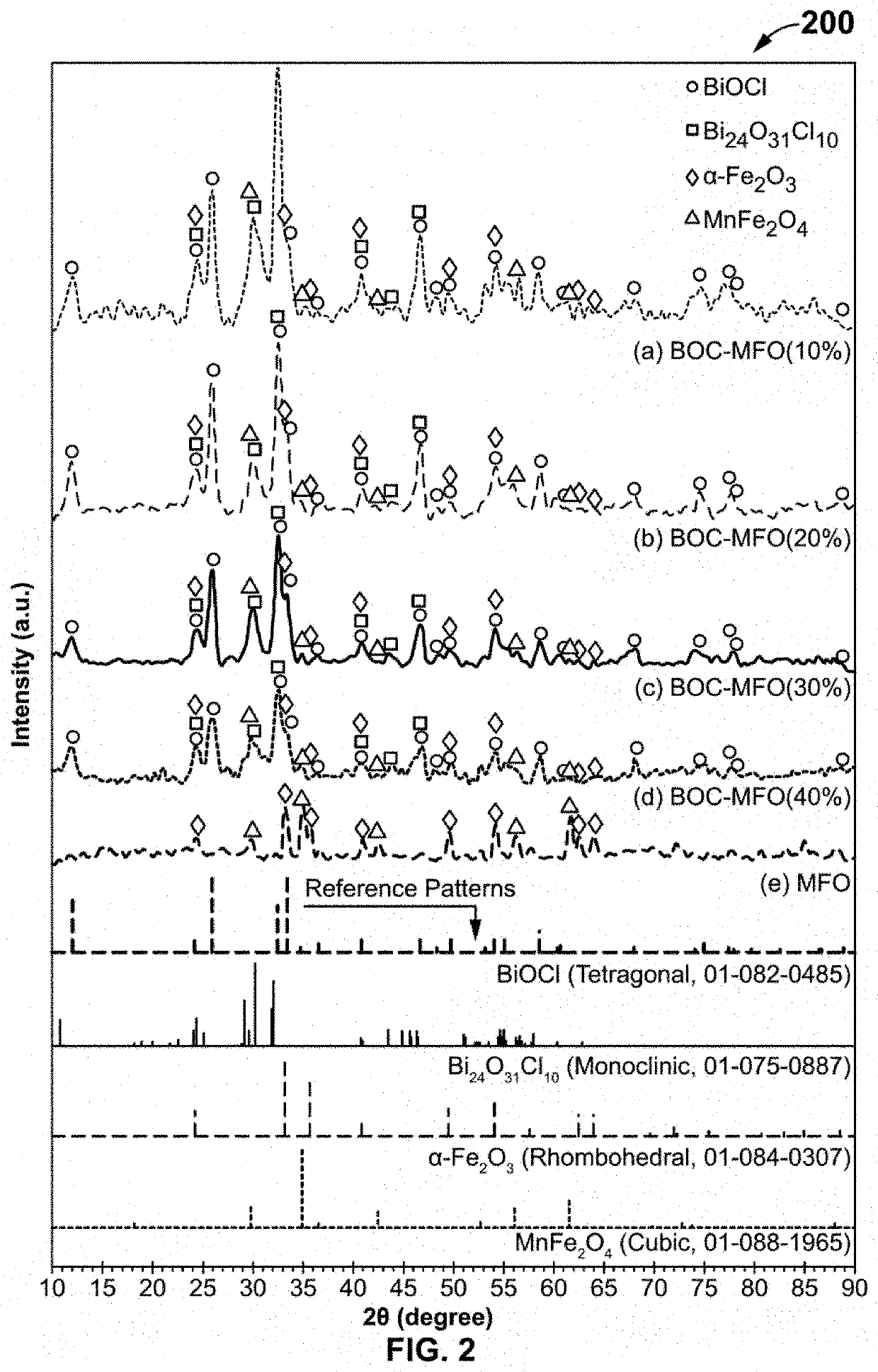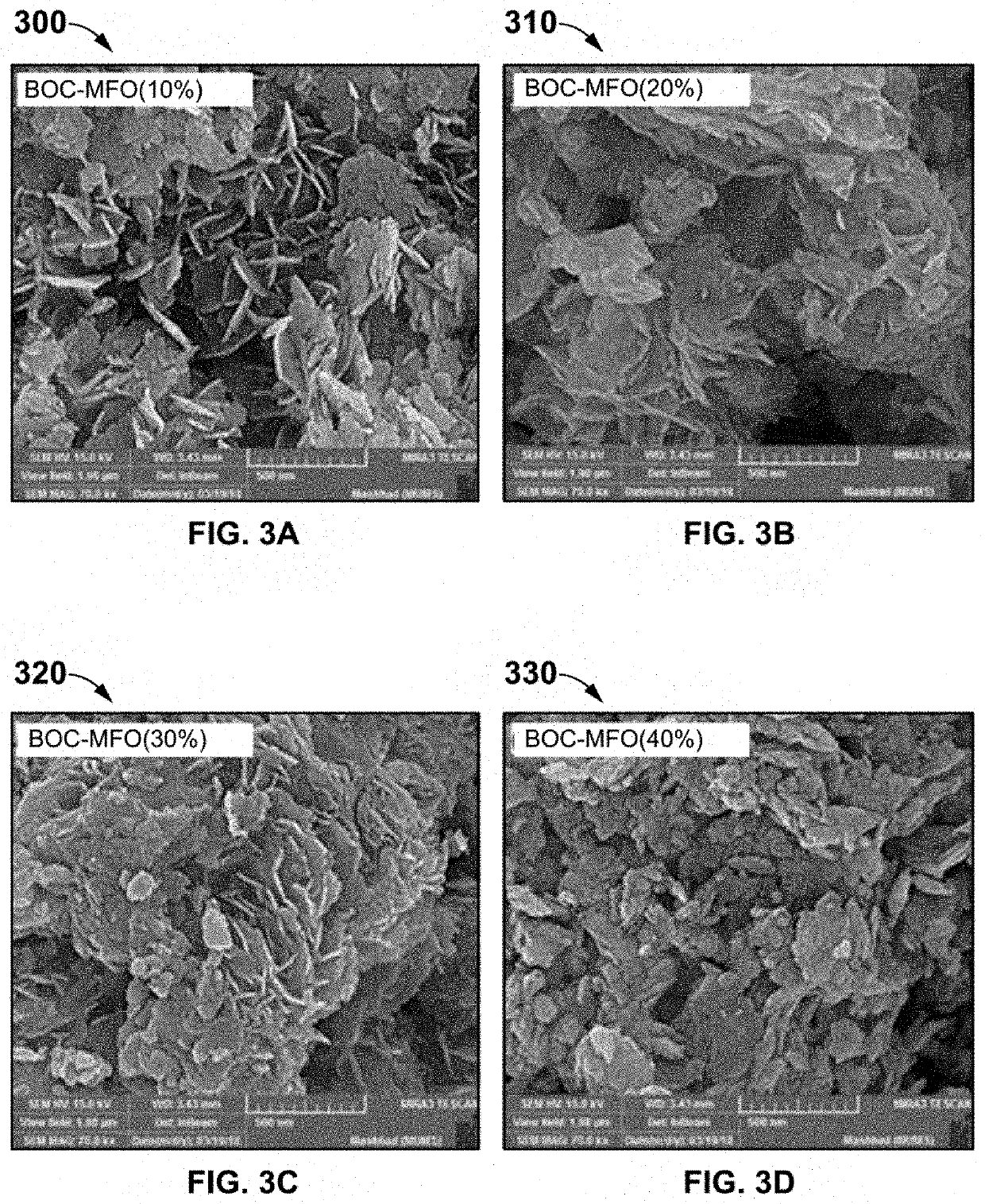Semiconductor photocatalyst and preparation method thereof
a technology of photocatalyst and semiconductor, applied in the field of semiconductor photocatalyst and preparation method thereof, can solve the problems of high risk and danger of these pollutants, destroying the microbial population in soil and water, and reducing the immunity of microorganisms and bacteria, so as to reduce the generation of reactive oxygen species, reduce the process efficiency, and reduce the effect of efficiency
- Summary
- Abstract
- Description
- Claims
- Application Information
AI Technical Summary
Benefits of technology
Problems solved by technology
Method used
Image
Examples
example 1
sis
[0067]Referring to FIG. 2, exemplarily illustrates a graph 200 of X-ray diffraction patterns of BiOCl—Bi24O31Cl10 / MnFe2O4—Fe2O3 semiconductor is disclosed. Results relevant to the X-ray powder diffraction (XRD) analysis of BOC-MFO of 10 wt %, BOC-MFO of 20 wt %, BOC-MFO of 30 wt % and BOC-MFO of 40 wt % and MFO are illustrated in FIG. 2. For BOC-MFO nanocomposites with various amounts of MFO, the characteristic peaks were well indexed to the phase of BiOCl with the tetragonal crystal structure and the lattice parameters a=b=3.887 and c=7.354 Å (JCPDS NO. 01-082-0485), the monoclinic Bi24O31Cl10 with the lattice constants a=9.995, b=3.969 and c=9.440 Å (JCPDS NO. 01-075-0887), the α-Fe2O3 phase with the rhombohedral crystal structure (JCPDS File: 01-084-0307) at 20=24.2, 33.2, 35.7, 41.0, 49.6, 54.2, 62.6 and 64.2° and the cubic phase of MnFe2O4 (JCPDS File: 01-088-1965) at around 20=29.7, 35.0, 42.5, 56.2 and 61.7 that indicated in all nanocomposites synthesized by sono-solvother...
example 2
[0069]FESEM (field emission scanning electron microscopy) images (300, 310, 320, 330) of BOC-MFO of 10 wt %, BOC-MFO of 20 wt %, BOC-MFO of 30 wt % and BOC-MFO of 40 wt % samples are displayed in FIG. 3A-FIG. 3D, respectively. As observed, the magnetic BOC-MFO nano-photocatalyst of 10 wt % has the nanosheet morphology, which these nanosheets contain nanoparticles of MFO. With increasing the content of MFO, the existing nanosheets were gradually stacked together, leading to the formation of plate-like clusters. The reason of the stacking and agglomeration of nanosheets and particles could be attributed to the interaction between magnetic nanoparticles. So that, with increasing the content of MFO, the stacking and agglomeration phenomenon was increased. This event could lead to a decrease in the surface adsorption and consequently a decrease in the photocatalytic activity of sample.
[0070]Referring to FIG. 4A-FIG. 4D, the surface structure of the BOC-MFO nano-photocatalyst of 10 w...
example 3
apping Analysis
[0071]Referring to FIG. 5A, the presence of Bi, O, Cl, Mn and Fe elements is confirmed in the structure of BOC-MOF (10%) sample from the EDX (energy dispersive X-ray) analysis image 500. A dot-mapping image 510 of all elements is represented in FIG. 5B.
[0072]FIG. 5C exemplarily illustrates a dot-mapping image 520 of Bi in BiOCl—Bi24O31Cl10 / MnFe2O4—Fe2O3 semiconductor of 10 wt %, according to an embodiment of the present invention. FIG. 5D exemplarily illustrates a dot-mapping image 530 of Cl in BiOCl—Bi24O31Cl10 / MnFe2O4—Fe2O3 semiconductor of 10 wt %, according to an embodiment of the present invention.
[0073]FIG. 5E exemplarily illustrates a dot-mapping image 540 of Mn in BiOCl—Bi24O31Cl10 / MnFe2O4—Fe2O3 semiconductor of 10 wt %, according to an embodiment of the present invention. FIG. 5F exemplarily illustrates a dot-mapping image 550 of Fe in BiOCl—Bi24O31Cl10 / MnFe2O4—Fe2O3 semiconductor of 10 wt %, according to an embodiment of the present invention. Moreover, the ...
PUM
| Property | Measurement | Unit |
|---|---|---|
| frequency | aaaaa | aaaaa |
| temperature | aaaaa | aaaaa |
| size distribution | aaaaa | aaaaa |
Abstract
Description
Claims
Application Information
 Login to View More
Login to View More - R&D
- Intellectual Property
- Life Sciences
- Materials
- Tech Scout
- Unparalleled Data Quality
- Higher Quality Content
- 60% Fewer Hallucinations
Browse by: Latest US Patents, China's latest patents, Technical Efficacy Thesaurus, Application Domain, Technology Topic, Popular Technical Reports.
© 2025 PatSnap. All rights reserved.Legal|Privacy policy|Modern Slavery Act Transparency Statement|Sitemap|About US| Contact US: help@patsnap.com



